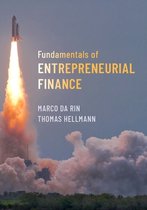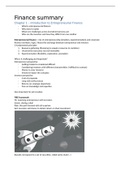Finance summary
Chapter 1 – Introduction to Entrepreneurial Finance
- What is entrepreneurial finance
- Why does it matter
- What core challenges across investment process are
- Who are the investors and how they differ from one another
Entrepreneurial finance = mix of entrepreneurship (intuition, experimentation) and corporate
finance (numbers, logic). About the exchange between entrepreneur and investor.
3 fundamental principles
1. Resource gathering (financing to acquire resources to combine)
2. Uncertainty (outcomes not yet knowable)
3. Experimentation (flexibility, exploration, pivotable)
Why is it challenging and important?
Entrepreneur perspective
- Getting funded is considered difficult
- Considering investors with different characteristics (+difficult to contact)
- Money is a key resource
- Investors impact the company
Investor perspective
- A lot of proposals
- Long and costly process
- Returns (or strategic objectives)
- Pass on knowledge and expertise
Also important for job creation.
FIRE framework
Fit: matching entrepreneur with investors
Invest: closing a deal
Ride: the path forward with all surprises
Exit: investors sell shares to obtain return on their investment
Rounds correspond to a set of securities, called series (A,B,C…)
,FUEL framework
Fundamental structure: who is the investor
Underlying motivation: what does he want
Expertise and networks: what does he contribute
Logic and style: how does he operate
Main types of investors
- VC (venture capitalist) = raising funding from institutional investors
- Founders = savings, credit
- External = 3 f’s (friends, family, fools), Angel investors, corporations, intrapreneurs,
crowdfunding, peer-to-peer.
, Chapter 2 – Evaluating venture opportunities
- Framework for evaluating venture opportunities
- Breaking down value proposition
- Assess the attractiveness, risks and competitive advantage of a new venture
- Perform due diligence on a new venture’s business plan
Can use the VEM matrix
Need
- What exactly is the customer need?
- How strong is the need? How well do customers understand it?
- How much are customers able and willing to pay?
Solution
- Does the proposed solution solve the customer’s need?
- How does the proposed solution compare to the alternatives?
- To what extent can the innovation be protected?
Team
- Do the founders have the required skills and experience?
- What are their motivation and commitment?
- Is the founders’ team complementary and cohesive?
Market
- How large is the target market?
- How fast will the target market grow?
- How will adoption take place?
Competition
- Who are current and future competitors?
- What is the nature of competition?
- How can the venture differentiate itself?
Network
- What is the founding team’s reputation?
- What networks does the team have access to?
- How does the team forge and maintain new relationships?
Chapter 1 – Introduction to Entrepreneurial Finance
- What is entrepreneurial finance
- Why does it matter
- What core challenges across investment process are
- Who are the investors and how they differ from one another
Entrepreneurial finance = mix of entrepreneurship (intuition, experimentation) and corporate
finance (numbers, logic). About the exchange between entrepreneur and investor.
3 fundamental principles
1. Resource gathering (financing to acquire resources to combine)
2. Uncertainty (outcomes not yet knowable)
3. Experimentation (flexibility, exploration, pivotable)
Why is it challenging and important?
Entrepreneur perspective
- Getting funded is considered difficult
- Considering investors with different characteristics (+difficult to contact)
- Money is a key resource
- Investors impact the company
Investor perspective
- A lot of proposals
- Long and costly process
- Returns (or strategic objectives)
- Pass on knowledge and expertise
Also important for job creation.
FIRE framework
Fit: matching entrepreneur with investors
Invest: closing a deal
Ride: the path forward with all surprises
Exit: investors sell shares to obtain return on their investment
Rounds correspond to a set of securities, called series (A,B,C…)
,FUEL framework
Fundamental structure: who is the investor
Underlying motivation: what does he want
Expertise and networks: what does he contribute
Logic and style: how does he operate
Main types of investors
- VC (venture capitalist) = raising funding from institutional investors
- Founders = savings, credit
- External = 3 f’s (friends, family, fools), Angel investors, corporations, intrapreneurs,
crowdfunding, peer-to-peer.
, Chapter 2 – Evaluating venture opportunities
- Framework for evaluating venture opportunities
- Breaking down value proposition
- Assess the attractiveness, risks and competitive advantage of a new venture
- Perform due diligence on a new venture’s business plan
Can use the VEM matrix
Need
- What exactly is the customer need?
- How strong is the need? How well do customers understand it?
- How much are customers able and willing to pay?
Solution
- Does the proposed solution solve the customer’s need?
- How does the proposed solution compare to the alternatives?
- To what extent can the innovation be protected?
Team
- Do the founders have the required skills and experience?
- What are their motivation and commitment?
- Is the founders’ team complementary and cohesive?
Market
- How large is the target market?
- How fast will the target market grow?
- How will adoption take place?
Competition
- Who are current and future competitors?
- What is the nature of competition?
- How can the venture differentiate itself?
Network
- What is the founding team’s reputation?
- What networks does the team have access to?
- How does the team forge and maintain new relationships?



